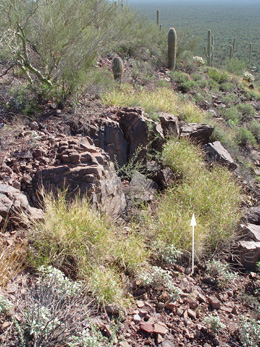buffelgrass control
Buffelgrass (Pennisetum ciliaris) was first introduced in the 1930s into southern Arizona primarily for use in roadside and rangeland revegetation. It has since spread into non-seeded areas and has become a major threat to lower Sonoran Desert plant communities. Buffelgrass is well adapted to fire and increased fire intensity and frequency on buffelgrass-infested sites is affecting vegetation composition in these environments where fire is typically very infrequent.
Travis Bean is involved in multiple projects dealing with buffelgrass biology and control. His work concerns both population biology and practical control methods.
We conducted research focusing on characteristics that may explain this species success in invasion. For example, as part of her M.S. research, Judy Ward described the amount of precipitation required for buffelgrass seeds to germinate and establish. Her work showed that rainfall events sufficient for buffelgrass establishment occur in about 50% of summer rainy seasons in Tucson. [PDF]



